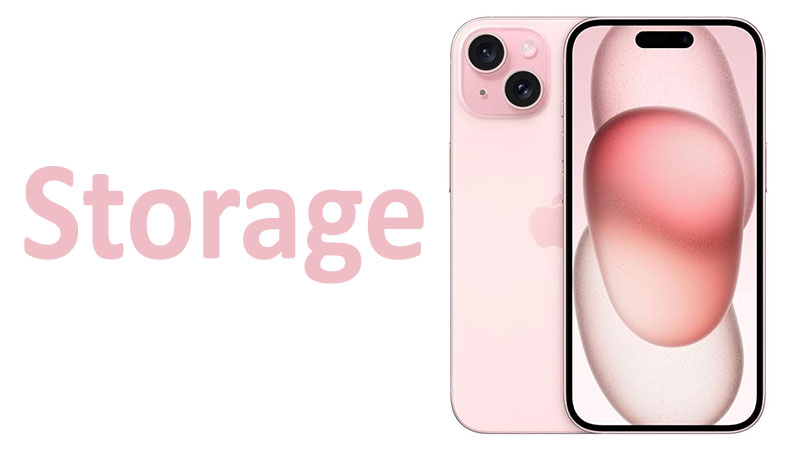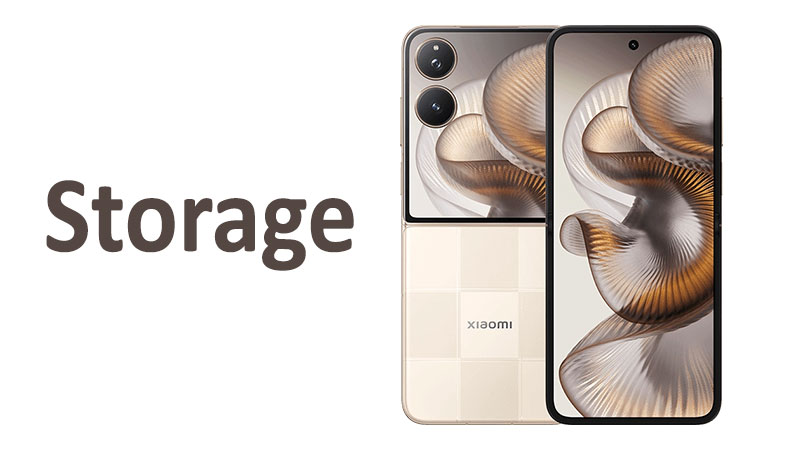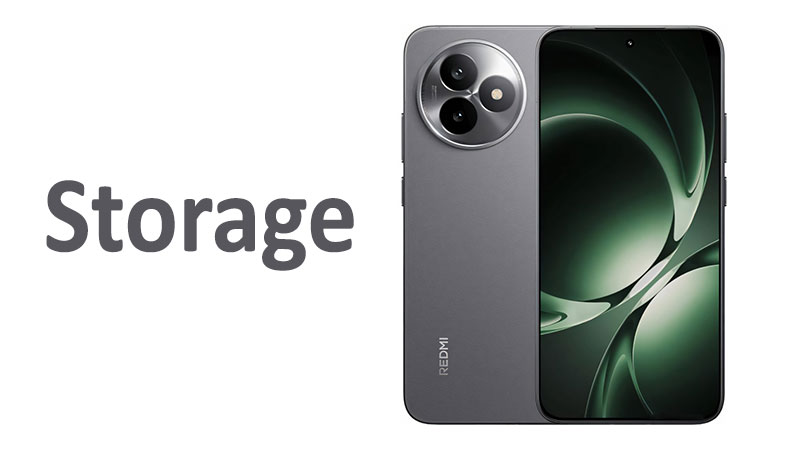The Apple iPhone 15 storage system is fundamental to its overall performance and user experience. Choosing the right memory configuration is an essential decision for every prospective buyer. This choice impacts everything from app load times to long-term digital freedom. The iPhone 15 series continues Apple’s tradition of using fast, proprietary internal memory. This memory is key to the seamless integration of hardware and software. This comprehensive guide will analyze the capacity options, the underlying NVMe technology, and vital factors for a smart purchase. We aim to provide a detailed, clear roadmap for navigating your iPhone 15 storage selection. Understanding these details will ensure your new device meets your needs for years to come.
Configurations and Capacity Tiers
The iPhone 15 base model offers three distinct storage configurations. Apple pairs each capacity with a fixed amount of system memory, or RAM. This streamlined approach simplifies the buying process. It ensures a consistent, high-speed experience across the entire lineup. The storage options cater to a wide spectrum of users. This ranges from the casual user to the dedicated media creator.
The Available iPhone 15 Storage Models
The iPhone 15 storage tiers reflect modern smartphone usage demands. Each option balances cost, capacity, and anticipated data needs. All configurations utilize 6GB of RAM. This RAM capacity is sufficient for managing iOS processes and standard multitasking.
The three primary configurations are:
- 128GB Internal Storage with 6GB RAM
- 256GB Internal Storage with 6GB RAM
- 512GB Internal Storage with 6GB RAM
The 6GB RAM is a crucial component of the phone’s performance architecture. It ensures smooth operation, even when multiple apps run in the background. It is a key factor in the device’s overall responsiveness. This memory standardization means performance speed is determined primarily by storage technology. This technology is uniform across all capacity tiers.
The Role of 6GB RAM in iPhone 15 Performance
The iPhone 15 features 6GB of high-speed LPDDR5 RAM. RAM acts as the device’s short-term working memory. It allows the phone to quickly access data needed for currently running tasks. This is different from the long-term storage where files reside permanently.
The 6GB capacity efficiently handles daily activities. For example, it allows for app switching and web browsing with many open tabs. It also supports demanding applications and basic mobile gaming. Crucially, the operating system, iOS, is highly optimized. It manages memory resource allocation more efficiently than some competing mobile platforms. This optimization allows 6GB RAM to deliver performance comparable to devices with larger RAM. Therefore, the memory is not a bottleneck for the iPhone 15 experience.
Specialized Comparison: iPhone 15 vs. iPhone 14 Base Storage
The storage approach of the iPhone 15 largely follows the pattern set by its predecessor. The iPhone 14 also offered 128GB as its minimum capacity. This consistency reflects Apple’s belief that 128GB is the current viable starting point. This capacity balances affordability with usability for new owners.
However, the iPhone 15 did see a subtle, but important, RAM change compared to previous generations. The consistent RAM across all models ensures a level playing field for performance. This contrasts with earlier generations where RAM size sometimes varied between the base and Pro models. The overall storage architecture provides familiar yet refined performance metrics. Users upgrading from the iPhone 14 will find the core storage options identical. They will only need to choose based on their growing data consumption.
The Technology Behind the Speed: NVMe SSD
The speed and responsiveness of the iPhone 15 rely heavily on its storage type. Apple utilizes proprietary NVMe storage modules. NVMe stands for Non-Volatile Memory express. This technology is a high-speed interface protocol. It allows the phone’s A-series chip to communicate with the flash storage instantly. This setup is the secret to the iPhone’s renowned fluid operation.
Deep Dive into NVMe Flash Storage
NVMe SSDs are essentially small, highly optimized solid-state drives. They connect directly to the main processor via the high-speed PCIe bus. This direct connection eliminates bottlenecks found in older storage interfaces. The result is significantly faster data transfer rates.
This speed is crucial for everyday tasks. Consider downloading a large application or game. The NVMe technology writes the data to the memory extremely quickly. Opening memory-intensive apps also happens almost instantaneously. NVMe storage provides superior random read and write speeds. These speeds are far more important than simple sequential speeds. They directly impact how fast the phone feels when multitasking.
NVMe Performance and iOS Synergy
Apple designs the NVMe storage controller and iOS to work together seamlessly. The controller manages data flow between the processor and the storage chips. Apple fine-tunes this integration for maximum efficiency and speed. This synergy means the performance figures are not just theoretical. They translate into real-world speed advantages.
For example, when capturing a burst of high-resolution photos, the phone writes massive amounts of data in seconds. The NVMe system handles this extreme workload without stuttering. Similarly, booting the device is a lightning-fast process. This optimization is a key reason why iPhones maintain their fast performance over several years.
Specialized Comparison: NVMe vs. UFS Storage
The primary competitor to Apple’s NVMe in the smartphone world is Universal Flash Storage (UFS). UFS is commonly used in high-end Android phones. Both UFS 4.0 and Apple’s latest NVMe are incredibly fast. However, they follow different architectural paths.
UFS is an industry standard designed for broad compatibility. NVMe is a proprietary, highly customized solution within the Apple ecosystem. While UFS 4.0 boasts impressive sequential speeds, Apple’s NVMe is optimized for low-latency random operations. Random reads and writes are key to a fluid user interface. Therefore, for the specific demands of iOS, Apple’s NVMe typically provides superior responsiveness. This difference is subtle, but it contributes to the signature feel of an iPhone.
Capacity Deep Dive and Ideal Buyer Profiles
Choosing the correct storage capacity is the most critical decision for buyers. The iPhone 15 offers three capacity tiers. Each one corresponds to a different user type and budget. Since the storage is fixed, careful planning is necessary to avoid future frustration.
128GB: The Entry Point and Cloud-Centric User
The 128GB model is the most affordable entry into the iPhone 15 family. This capacity is suitable for a specific type of user. It is best for those who rely heavily on cloud services.
Pros and Cons of 128GB
Pros:
- It offers the lowest purchase price, maximizing budget savings.
- The capacity is enough for core applications and a moderate photo library.
- It works perfectly for users who routinely stream media and use iCloud or other cloud backups.
- It retains the same high-speed NVMe performance as the larger models.
Cons:
- Heavy video recording in 4K or Pro will quickly fill the space.
- Users who download many large mobile games will face frequent management issues.
- You must regularly offload or delete data to maintain available space.
Ideal User Profile for 128GB
This model is ideal for the casual or cloud-centric user. This person primarily communicates, browses the web, and uses social media. They stream all their music and movies. They utilize iCloud Photos to store original, high-resolution media in the cloud. They only keep optimized, smaller versions on the phone. This user avoids downloading large local files.
256GB: The Sweet Spot and Balanced User
The 256GB model is often considered the ideal balance of cost and space. It provides a generous buffer for nearly all common usage scenarios. Most users will find this capacity sufficient for the entire life of the phone.
Pros and Cons of 256GB
Pros:
- It offers a good price-to-capacity ratio, representing solid value.
- This capacity provides comfortable overhead for a large photo and video library.
- It easily handles many large games and professional utility applications.
- It reduces the need for constant file management and cloud reliance.
Cons:
- It still requires some management if you heavily record 4K/60fps video regularly.
- The price jump from 128GB is a notable additional investment.
Ideal User Profile for 256GB
The 256GB configuration is perfect for the average, balanced flagship consumer. This user enjoys mobile gaming and takes many photos and videos. They may not upload everything immediately to the cloud. They appreciate having local copies of their favorite albums or videos for offline viewing. This capacity minimizes anxiety about running out of space for most users. It provides excellent peace of mind.
512GB: The Power User and Digital Maximalist
The 512GB model is the largest capacity offered for the iPhone 15 base models. It is built for the professional and the maximalist user. This choice completely eliminates capacity as a concern.
Pros and Cons of 512GB
Pros:
- It provides massive, industry-leading storage capacity for the base model iPhone.
- This capacity is essential for serious content creation, especially long-form 4K video.
- It offers the ultimate future-proofing against the ever-increasing size of apps and media.
- The phone can act as a standalone library for photos, videos, and music.
Cons:
- This option demands the highest initial investment cost.
- Many users will find the space excessive, resulting in unused capacity.
Ideal User Profile for 512GB
The 512GB iPhone 15 is the definitive choice for the power user. This includes mobile videographers, photographers who shoot in raw formats, and heavy media consumers. They frequently download large files for professional work or entertainment. They do not want to manage storage or rely on internet connectivity. This is the only option that truly offers worry-free, long-term data storage.
Key Considerations for Buyers
The iPhone 15 storage decision is a long-term commitment. Buyers must consider several key factors beyond just the numerical capacity. These factors affect the phone’s usability and financial value over its ownership period.
The Fixed Storage Reality: No Card Slot
The iPhone 15, like all iPhones before it, does not include a microSD card slot. This means the storage capacity you select at purchase is the only storage you will ever have. This is a critical point of difference from many competing Android devices.
This lack of expandability solidifies the need for careful up-front planning. If you anticipate your data needs growing significantly, it is wise to size up. Upgrading the internal memory later is impossible. Therefore, treat your chosen capacity as a hard and fast limit. For users transitioning from an Android phone with expandable storage, this reality requires an adjustment. You must factor in potential future data growth when making your initial choice.
Future-Proofing and Data Growth
Digital file sizes consistently increase every year. Photos and videos taken today are higher resolution than they were just a few years ago. This trend directly impacts your storage longevity. 4K video recording, especially at 60 frames per second, consumes space quickly.
Future-proofing means choosing a capacity that can absorb this continuous data inflation. The operating system and updates also take up more space over time. A 128GB iPhone 15 might be functionally fast for three years. However, it will likely require aggressive data management by that point. Choosing 256GB or 512GB offers significantly better defense against premature storage exhaustion. It ensures the phone remains convenient to use throughout its expected lifespan.
Cost Versus Value Analysis
The price difference between the storage tiers is often substantial. This cost must be weighed against the value of convenience and future-proofing.
For example, the price difference between 128GB and 256GB buys you an additional 128GB of internal, NVMe-speed storage. This is a high price per gigabyte compared to generic external storage. However, you are paying for the speed, integration, and permanent availability of that space. For the heavy user, the cost of the 256GB or 512GB upgrade is worthwhile. It avoids the frustration of constant storage warnings and file management. For the light user, the cheaper 128GB option provides the best value. They can use the cost savings for accessories or cloud subscriptions.
Specialized Comparisons and Context
Placing the iPhone 15 storage system in context against previous models and the Pro lineup highlights its specific position in the market. This specialized comparison helps buyers understand where the iPhone 15 truly stands.
iPhone 15 vs. iPhone 14 Storage (Architecture)
The iPhone 15 and iPhone 14 share the same core capacity options: 128GB, 256GB, and 512GB. They also both utilize NVMe technology. Therefore, the speed difference between the two is minimal for most users.
The main difference lies in Apple’s continuous refinement of the NVMe controller and memory density. This refinement results in slightly optimized read and write operations. Overall, a user upgrading from the iPhone 14 will not notice a major storage speed leap. Instead, the upgrade is primarily about the camera and processor improvements. The storage consistency ensures a reliable performance baseline.
iPhone 15 vs. iPhone 15 Pro Storage (Feature Disparity)
The comparison between the base iPhone 15 and the high-end iPhone 15 Pro models is crucial. It reveals a specific trade-off related to storage. The Pro models often introduce a higher top-tier capacity, such as 1TB. They also offer enhanced camera features that specifically demand more storage.
For instance, the ability to record high-quality ProRes video may be limited on the base 128GB iPhone 15 Pro model. This limitation forces Pro users to purchase a higher capacity. The base iPhone 15 lacks these extreme pro video features. Therefore, the 512GB top capacity is more than adequate for the base model’s feature set. Buyers should realize the iPhone 15 storage is designed for standard high-end usage. It is not designed for the extreme data demands of cinematic video codecs.
Pros and Cons of the iPhone 15 Storage System
The iPhone 15 storage architecture is a deliberate choice by Apple. It emphasizes speed and simplicity. This approach brings with it distinct advantages and disadvantages.
Pros of the iPhone 15 Storage
The integrated memory solution offers several clear benefits to the user.
- Superior Speed: The NVMe technology delivers extremely fast random and sequential speeds. This results in instant app launching and smooth operation.
- Consistent Performance: All capacity tiers offer the same high-speed performance due to the standardized NVMe and 6GB RAM.
- Data Security: Fixed internal storage is inherently more secure than removable media. Data access and encryption are tighter.
- Durability: Internal storage lacks the physical vulnerability of an external card slot. This improves the phone’s overall resilience.
Cons of the iPhone 15 Storage
The lack of flexibility is the main drawback of this system.
- Fixed Capacity: The user is permanently locked into their initial storage selection. No possibility exists for future, budget-friendly expansion.
- Higher Entry Cost: Compared to Android phones, the iPhone’s minimum capacity often comes at a higher starting price.
- Costly Upgrades: The price increase for stepping up to the next storage tier is significant. This makes capacity upgrades an expensive decision.
Essential Buyer’s Checklist
Buyers should use this final checklist before finalizing their storage choice.
- Assess Current Usage: Check the storage currently used on your old device. Add 50% to this number for future growth over three years.
- Factor in Video: If you plan to record 4K/60fps video frequently, consider the 512GB option. Even the 256GB can become quickly saturated by video files.
- Utilize Cloud: If you are comfortable managing your data entirely via services like iCloud or Google Photos, the 128GB model remains a viable choice.
- Understand NVMe: Recognize that you are paying a premium for extremely fast, stable, and integrated NVMe storage. The speed difference compared to external media is vast.
Conclusion
The Apple iPhone 15 storage system delivers uncompromising speed and a reliable user experience. Its reliance on high-speed NVMe flash memory ensures that app loading and data handling remain exceptionally fast. The standardized 6GB of RAM contributes to smooth, lag-free multitasking across all models.
Buyers face a critical choice between three tiers: 128GB, 256GB, and 512GB. The absence of a microSD card slot makes this choice final and permanent. Therefore, cautious overestimation of future data needs is highly recommended. Most users will find the 256GB model to be the ideal combination of cost and capacity. It offers a comfortable buffer for high-quality media and apps. The 512GB option is reserved for the true content creator and digital maximalist. It provides worry-free longevity and storage freedom. By carefully analyzing your habits and anticipating future data growth, you can select the perfect iPhone 15 storage configuration. This guarantees satisfaction throughout your device’s lifespan.
FAQ
Does the Apple iPhone 15 come with a microSD card slot?
No, the iPhone 15 does not include a microSD card slot. Its storage capacity is fixed upon purchase.
What is the minimum storage capacity for the iPhone 15?
The minimum storage capacity available for the base iPhone 15 model is 128GB.
What type of storage technology does the iPhone 15 use?
The iPhone 15 uses high-speed NVMe (Non-Volatile Memory express) flash storage technology.
Do the 128GB and 512GB models have the same speed?
Yes, all iPhone 15 storage capacities utilize the same NVMe technology. They offer identical read and write speed performance.
How much RAM is included in the iPhone 15?
The iPhone 15 includes 6GB of LPDDR5 RAM across all the 128GB, 256GB, and 512GB storage configurations.



